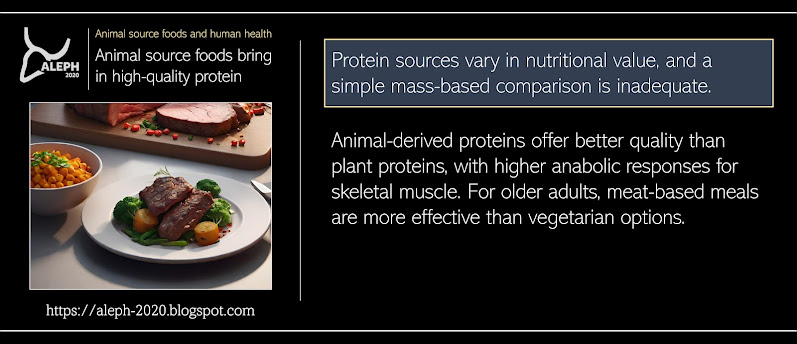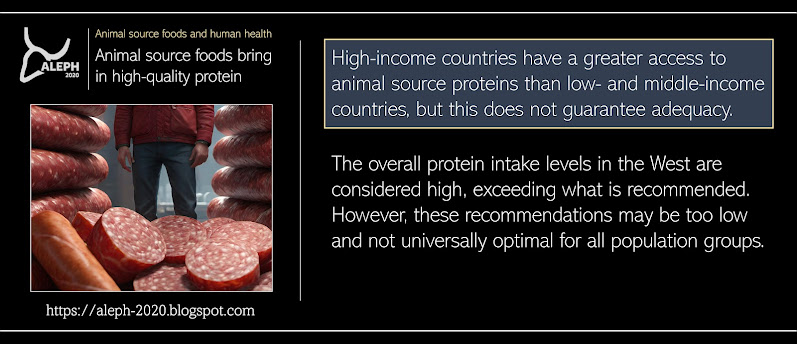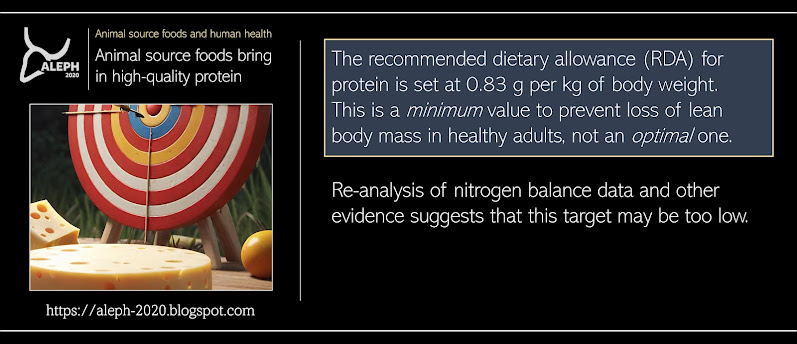The protein-to-carbohydrate ratio in a diet is associated with an enhanced supply of micronutrients and lower all-cause mortality. Nutritional adequacy also relies on protein quality, which is typically more favourable in animal-derived foods than in plants, based on the essential amino acid profiles and digestibility in the small intestine. To meet the essential amino acid needs adequately, plant-based diets may require higher protein amounts, and therefore also a higher intake of food and energy. This comes with practical challenges, especially in older adults. The recommended dietary allowance for protein has been estimated at 0.83 g per kg body weight per day, but may need to be revised to 1.0 g/kg based on new lines of evidence. Even higher protein intake seems to be beneficial for many if not most adults, with different optimal levels (1.2-2.2 g/kg) for specific groups like athletes, pregnant and lactating women, aging adults, and those with chronic diseases.
This article addresses the following three questions:
- Protein intake in high-income countries
- Recommendations may be too low for many
- Optimal protein intake varies per population
- Adequate protein as % of energy intake
- Protein sources differ in nutritional value
_________________________________
Protein intake in high-income countries
High-income countries have greater access to animal source proteins compared to low- and middle-income countries, but this does not guarantee adequacy. The overall protein levels in the West are considered high, exceeding what is recommended. However, these recommendations may be too low and not universally optimal for all population groups. Moreover, the claim that high protein intake may harm bone and kidney health is disputed, emphasizing a remarkable evolutionary adaptation to elevated protein levels.
Sufficient protein intake is the cornerstone of a healthy diet. Adding to its own nutritional importance, protein-to-carbohydrate ratio [Wabo et al. 2022] and high-quality protein [de la O et al. 2022] are associated with a more adequate supply of micronutrients in general, thus serving as markers for dietary adequacy. The protein-to-carbohydrate ratio is also associated with lower all-cause mortality [Wabo et al. 2022].High-quality protein from ASFs is more readily available in high-income countries (60% or more of dietary proteins) than in low- and middle-income countries (15-30% of dietary protein) [Tome et al. 2024]. In the EU, for instance, protein from ASFs covers 60% of the total, consisting mostly of meat (52%) and dairy (34%), followed by eggs (7%) and seafood (7%). Cereals and cereal products usually offer the largest share of plant proteins in Western diets [e.g., Lin et al. 2010]. These overall protein levels are said to be too high (about 70% higher than the 50 g/d recommendation for an adult of by the World Health Organization) [Westhoek et al. 2016].However, and in contrast to what some other authors claim [Mariotti & Gardner 2019], we argue that this contention overlooks that recommendations are (1) not met by substantial parts of the population, (2) not necessarily optimal, and (3) do not pay sufficient attention to protein quality. Moreover, claims that higher intake levels may harm bone and kidney health are unfounded [see elsewhere] and overlook that humans are evolutionary adapted to elevated protein levels [see elsewhere].
Recommendations may be too low for many
The recommended dietary allowance for protein is 0.83 g per kg of body weight. This is a minimum value to prevent loss of lean body mass in healthy adults, not an optimal one. Re-analysis of nitrogen balance data and other evidence suggests that this target may be too low. Many individuals may benefit from higher protein intake. Consuming below 1.3 g/kg/d could lead to muscle mass loss. It is crucial to note that the proposed nitrogen balance level may not necessarily be optimal for the entire population.
Further reading (summary of the literature):
The recommended dietary allowance (RDA) is estimated at 0.66 g protein per kg body weight per day, or 0.83 g/kg/d when taking variation into account [Richter et al. 2019; Tome et al. 2024]. This should be seen as a minimum value to avoid deficiency and loss of lean body mass in young adults specifically. However, re-analysis of nitrogen balance data and other new lines of evidence indicate that this recommendation may be too low and should be revised [Weiler et al. 2023]. Most adults benefit from higher protein intake [Layman, 2009; Philips et al. 2020], while eating below 1.3 g/kg/d may lead to loss of muscle mass [Tagawa et al. 2021]. Critically, the proposed level for nitrogen balance is not necessarily an optimal one for the entire population.
Optimal protein intake varies per population

The suggested daily protein intake may need to be revised from 0.83 to >1.0 g per kg of bodyweight. Even higher amounts, by at least doubling the value, are advised for specific groups, including athletes, pregnant and lactating women, older adults, and the diseased. These targets for optimal health are often not met. For instance, older adults in nursing homes tend to underconsume protein, while being less efficient at building or maintaining muscle mass.
Further reading (summary of the literature):
Whereas the suggested intake may have to be revised to at least 1.0 g/kg/d, this may even be higher for specific groups [Weiler et al. 2023]. Optimal muscle building, for instance, requires 1.6 g/kg/d with an upper limit for benefit at 2.2 g/kg/d [Iraki et al. 2019; Bagheri et al. 2023], or higher [up to 3.5 g/kg/d: Tagawa et al. 2021]. Older adults and elderly, which are about 40% less efficient than young adults at building muscle mass from protein, require intake levels of 1.0-1.5 g/kg/d for healthy aging [Wolfe et al. 2008; Deutz et al. 2014; Traylor et al. 2018; Groenendijk et al. 2019; Nishimura et al. 2021; Campbell et al. 2023; Weiler et al. 2023], and up to 2.0 g/kg/d or more in the case of acute or chronic disease [Wolfe et al. 2008; Bauer et al. 2013; Deutz et al. 2014]. A recent method (IAAO) suggests similar RDA values: 1.6 g/kg in active, trained adult males [Packer, 2015]; 1.6 g/kg in children older than three, 1.6-2.0 g/kg in pregnant women, and 1.2-1.3 g/kg in older adults [Tang et al., 2014; Arentzon-Lantz et al, 2015; Weiler et al. 2023]; 1.8 g/kg for endurance athletes [Kato et al., 2016]; 1.7-2.2 g/kg for young bodybuilders [Bandegan et al., 2017]; 1.8 and 1.5 g/kg for active male and female adolescents [Brooks et al., 2017], and 1.7-1.9g/kg for lactating women [Rasmussen et al. 2020]. Yet, in Dutch nursing homes, 85% of the residents were having a protein intake below the recommended 1 g/kg/d for elderly, corresponding with an average intake of only 0.8 (+/- 0.2) g/kg/d [Borkent et al. 2023].
Adequate protein as % of energy intake

Suitable protein intake depends on the overall diet. Instead of using a minimum RDA, protein needs can be expressed as a percentage of caloric intake. The recommended protein range is set at 10-35% of daily energy intake. The higher end of this range, corresponding with ancestral-type hunter-gatherer diets, has shown health benefits, including an improvement in cardiometabolic risk factors.
Further reading (summary of the literature):
Suitable intake also depends on the overall diet. For older adults eating three meals a day, a 1.2 g/kg/d target corresponds roughly to a 0.4 g protein/kg body weight/meal [Peters et al. 2023]. As a more pertinent recommendation than minimum RDA, an acceptable macronutrient distribution range (AMDR) for protein has been set at 10-35% on daily energy intake [Lupton 2020], of which the upper range is in the order of ancestral-type hunter-gatherer diets (19-35%) [Eaton et al. 1997; Cordain et al. 2000]. Nowadays, the intake of proteins relative to energy tends to be higher for meat eaters (17-18%) than for vegetarians (14-15%) and vegans (11-14%) [Mariotti & Gardner 2019]. In a sedentary 19-year old male reference, the protein RDA would only constitute 8.5% of his energy intake, while 10 and 35% would correspond with 1.0 and 3.3 g/kg/d, respectively [Wolfe et al. 2008]. For healthy adults with ideal body weights, the recommended protein intake based on macronutrient considerations has thus been set at 1.4-2.0 g/kg/d.
Attempts have been made to link such % of intake to health outcomes. In the US (NHANES data), the worst outcome for all-cause mortality was found at 15% protein, and interestingly being slightly worse than 10%, while the lowest risk was found at 30-40%, which also matched better diet quality [Wabo et al. 2022]. When looking at global populations, diets leading to the least healthy cardiovascular outcomes were typified by lower protein intake (14% kcal) than the healthier ones (17% kcal) [Mente et al. 2023]. The upper range of intake % has been shown to lead to various health benefits, including the attenuation of gestational weight gain in pregnant women with obesity [Geiker et al. 2021].
When contrasting the upper range of protein intake (30%) with lower levels (15%) in prediabetic, obese subjects, improvement of blood glucose, insulin sensitivity, inflammation, and lean body mass outcomes is seen [Stentz et al. 2020]. Similarly, obese and insulin-resistant subjects improve their insulin sensitivity by 60–90% regardless of weight loss after a month on a high-protein diet (25-30%), compared to a normal protein diet (<20%) [González-Salazar et al. 2021]. Small yet favourable effects of such higher intake levels on cardiometabolic risk factors are also found for subjects with no chronic medical conditions [Vogtschmidt et al. 2021].
Protein sources differ in nutritional value
 Protein sources vary in nutritional value, and a simple mass-based comparison is inadequate. Animal-derived proteins offer better quality than plant proteins, with higher anabolic responses for skeletal muscle. For older adults, meat-based meals are more effective than vegetarian options. Plant-based strategies for muscle protein synthesis may need fortification or higher intake. On average, vegetarian diets are associated with lower muscle mass and strength. A recommended animal-to-plant protein ratio is 50:50, with a 40:60 ratio potentially suitable. The True Ileal Digestibility (DIAAS) method is more accurate than PDCAAS for assessing protein value. Animal proteins have higher DIAAS values than most plant proteins. The Essential Amino Acid 9 (EAA-9) score, considering personalized requirements, provides an alternative for precision nutrition based on age or metabolic conditions.
Protein sources vary in nutritional value, and a simple mass-based comparison is inadequate. Animal-derived proteins offer better quality than plant proteins, with higher anabolic responses for skeletal muscle. For older adults, meat-based meals are more effective than vegetarian options. Plant-based strategies for muscle protein synthesis may need fortification or higher intake. On average, vegetarian diets are associated with lower muscle mass and strength. A recommended animal-to-plant protein ratio is 50:50, with a 40:60 ratio potentially suitable. The True Ileal Digestibility (DIAAS) method is more accurate than PDCAAS for assessing protein value. Animal proteins have higher DIAAS values than most plant proteins. The Essential Amino Acid 9 (EAA-9) score, considering personalized requirements, provides an alternative for precision nutrition based on age or metabolic conditions.Further reading (summary of the literature):
Protein sources differ substantially in nutritional value and should not be compared on a simple per mass basis [Gwin et al. 2021; Adhikari et al. 2022; Connolly et al. 2023]. When protein quality is taken into account, protein is found to be deficient for the average adult in most countries of the world (gross protein, in contrast, would suggest sufficiency for most countries) [Moughan 2021]. Typically, ASFs offer improved protein quality compared to plant proteins [Wolfe et al. 2018; Soh et al. 2024]. Animal proteins offer a higher skeletal muscle anabolic response than plant proteins [Berrazaga et al. 2019; van Vliet et al. 2019], bringing in amino acids that may otherwise be in short supply (i.e., leucine, lysine, and methionine). For muscle anabolism, emphasis should be particularly on the intake of leucine [Traylor et al. 2018]. The food matrix also needs to be accounted for, as this defines protein digestibility.
PDCAAS and DIAAS
True ileal digestibility scores for the dietary indispensable amino acids (DIAAS) are superior when quantifying protein value compared to single faecal crude protein digestibility ones (PDCAAS) [FAO 2011]. Moreover, PDCAAS does not assign additional nutritional value to proteins with high biological value, overestimates the nutritional value/protein digestibility of foods that contain antinutrients, and overestimates the protein digestibility of foods with low digestibility when supplemented with the corresponding limiting AA [Tome et al. 2024]. For most ASFs, DIAAS values are ≥1, exceeding those of plant proteins (legumes: 0.6; cereals: 0.3-0.5), only approximated by soy (0.8-0.9) [Wolfe et al. 2018; Burd et al. 2019; Adhikari et al. 2022]. In plants, digestibility is reduced due to structural resistance, fibre, and anti-nutritional factors, which can be (partially) attenuated through processing [Wolfe et al. 2018; Almeida Sá et al. 2020]. For peas, for instance, the DIAAS increases from 0.6 in cooked peas to 0.8 in pea protein isolate [Rutherfurd et al. 2015]. For soy, DIAAS after processing and post-processing can either increase (e.g., for soy milk and soy concentrate) or decrease (e.g., for tofu and soy flour) [van den Berg et al. 2022].With DIAAS rather than PDCAAS, nuts, seeds, tofu, and pulses (except chickpeas) cannot claim to be a 'good source' (DIAAS > 0.75) of protein [Marinangeli & House 2017]. To meet the requirements for all essential amino acids, the recommended protein intake should account for the DIAAS of the diet if the value is <100% (1.0). Since a plant-based diet yields a DIAAS of about 0.65 on average [Wolfe et al. 2018], a minimum amount of 0.8 g/kg/d would translate into a required intake of 1.2 g/kg/d to meet all essential amino acid needs, while a level of 1.5 g/kg/d for healthy aging would correspond with 2.3 g/kg/d. Indeed, when protein intake is 0.6-0.8 g/kg/d, vegan and lacto-ovo vegetarian diets are more likely to be deficient in essential amino acids, especially lysine [Tallman et al. 2023]. For strict vegan diets, consuming the RDA (0.8 g/kg/d) is inadequate to produce nitrogen balance in men [Bartholomae & Johnston 2023]. Also, meeting the same protein target with plant options comes with caloric intakes that are more elevated (often double or triple, even with beans and nuts) [Wolfe et al. 2018]. In a Swiss sample, about 60% of the vegans did not reach the daily protein recommendation of 1 g/kg/d, which was partially ascribed to high quantities of low-protein soy drinks [Bez et al. 2024].
Older adults
Whereas meeting the protein target for older adults is feasible with meat-based meals, this is more difficult with vegetarian options, even when improving the flavour with spices [Peters et al. 2023]. Also, when providing whole-food meal options, those containing beef resulted in enhanced muscle protein synthesis rates in older adults than isonitrogenous variants that were plant-based [Pinckaers et al. 2023]. Plant-based strategies to stimulate muscle protein synthesis are possible, but may require amino acid fortification, ingestion of multiple protein sources, or higher intake [Gorissen et al. 2016]. On average, consuming vegetarian diets parallels lower muscle mass and hand grip strength, when compared to omnivorous diets [Bartholomae et al. 2022]. Other authors contend that meeting sufficient protein levels with plant-based options should not be problematic, albeit with more uncertainty in the case of older adults and provided that the diets are well-formulated [Mariotti & Gardner 2019].
To specifically take into account personalized requirements based on age or metabolic conditions, such as increased leucine needs for older adults, the Essential Amino Acid 9 (EAA-9) score has been developed as an alternative to DIAAS and PDCAAS [Forester et al. 2023]. As such, EAA-9 scores can be used to ensure that dietary recommendations are met for each essential amino acid, in the context of precision nutrition.
Animal protein and nutrient adequacy
Besides being of nutritional relevance as such, 'animal protein' is also a proxy for the supply of highly bioavailable priority micronutrients [see elsewhere]. In a 12-w randomized controlled trial, diets with only 30% of the protein coming from animals led to lower vitamin B12 intake and status compared to a 50% share, which in turn was lower than for a 70% share; iodine intake and status were also lower in diets set at 30-50% of animal protein compared to 70% [Pellinen et al. 2022]. Modelling suggests that animal protein should be about 50% of total protein to avoid dietary inadequacy. A 40% contribution could be suitable for some populations, but 30% would probably be too low [Vieux et al. 2022; Tome et al. 2024]. As a reference, the contribution of animal protein to total protein in global diets is currently 10-30%, 20-40% 30-60%, and 50-70% for most low-, lower-middle-, upper-middle-, and high-income countries, respectively [Drewnowski 2024; see elsewhere].



